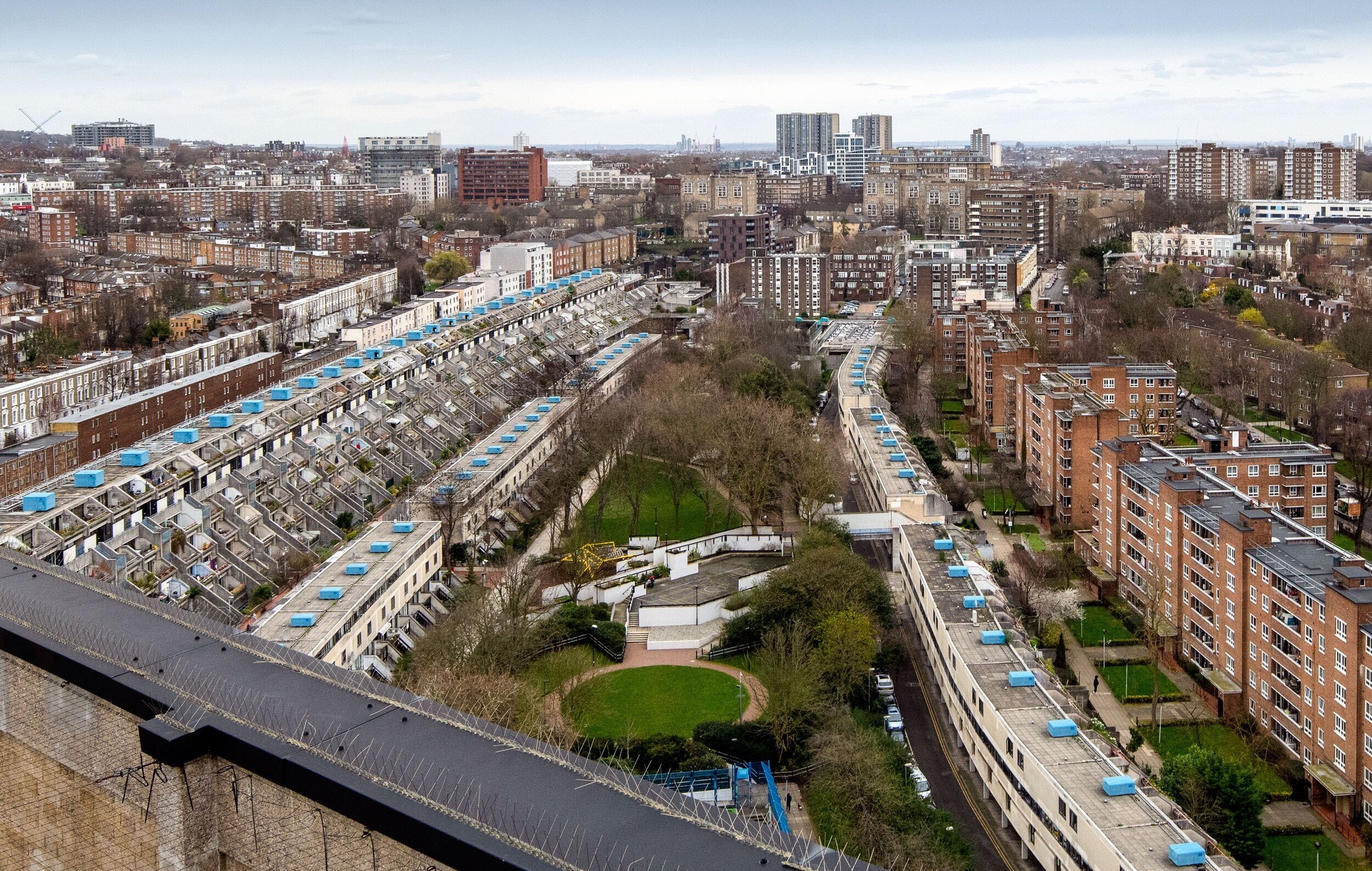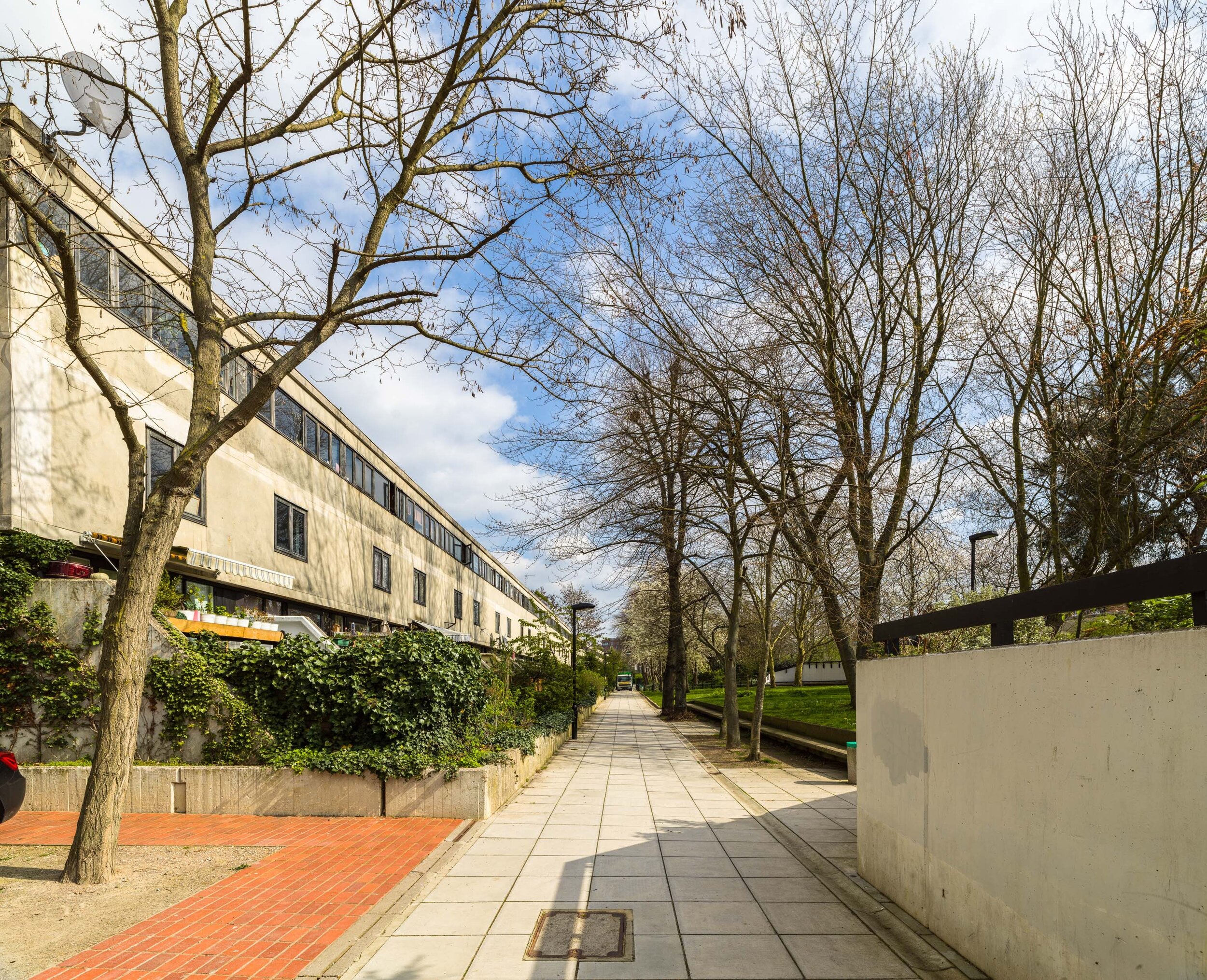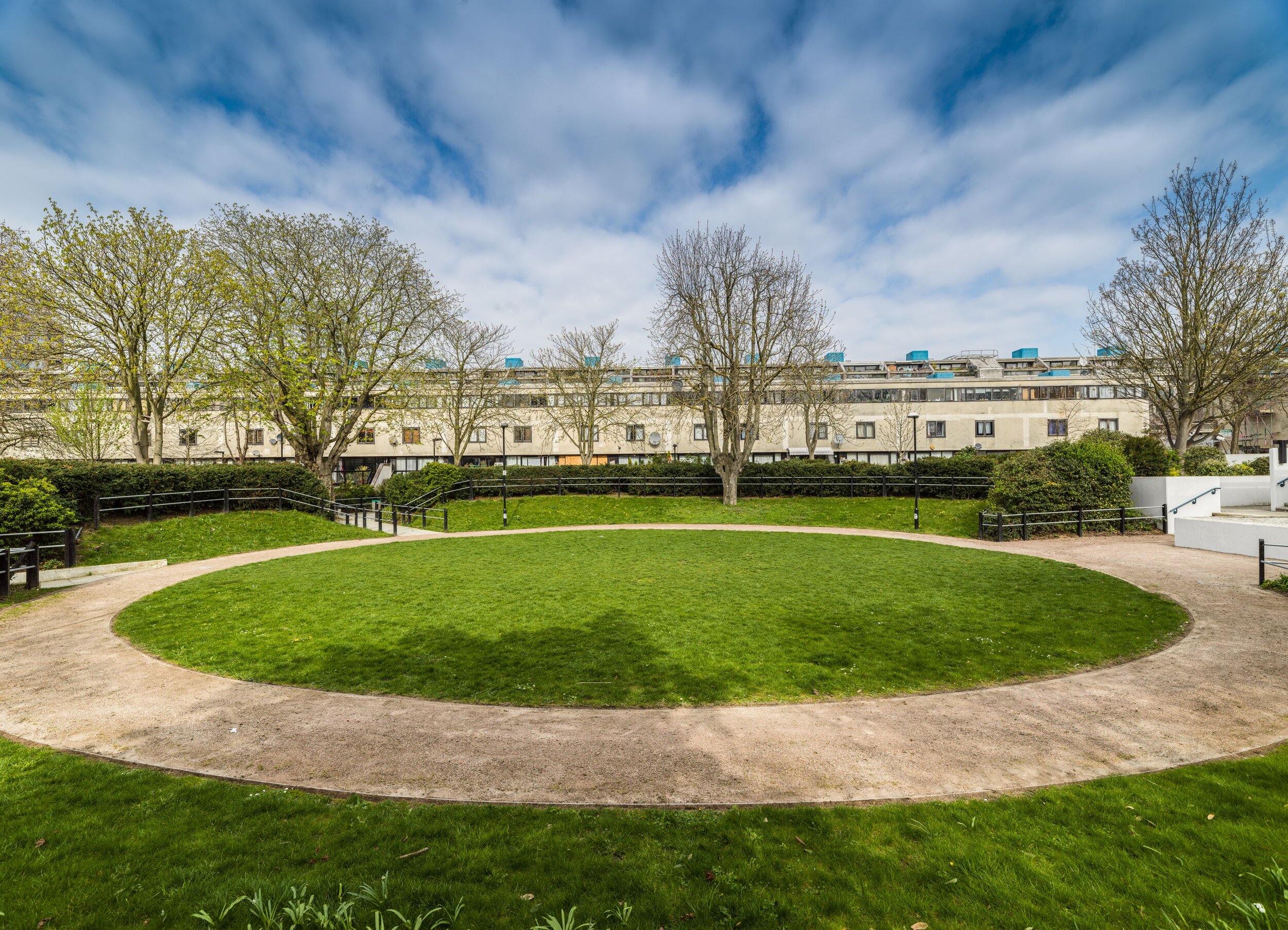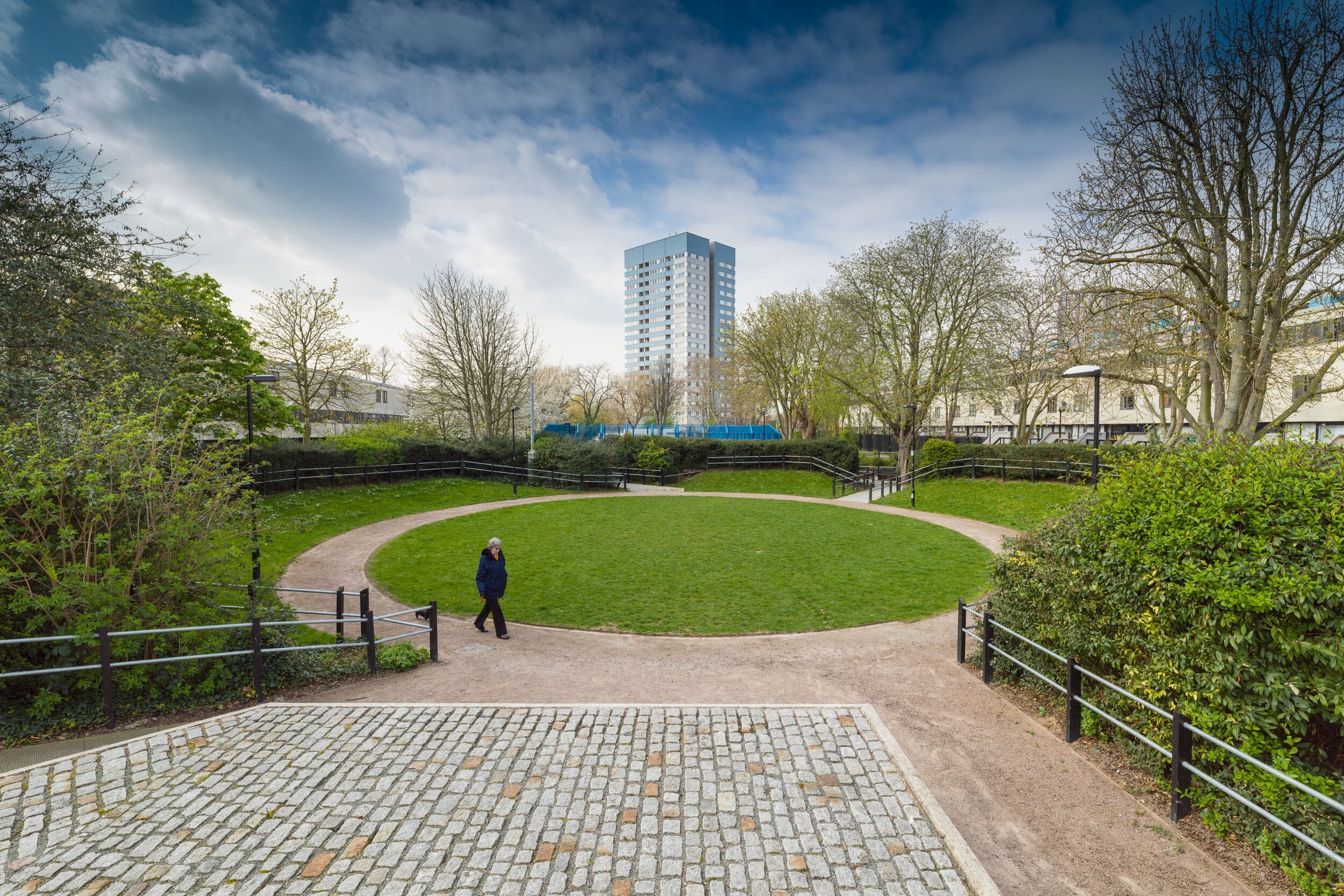Post-War Designed Landscapes – ‘A green place in which to live and work’: Landscapes by Sylvia Crowe and Janet Jack
In the third in our series on landscape architecture of the post-war years, Luca Csepely-Knorr and Karen Fitzsimon look at the far-ranging impacts of Sylvia Crowe and Janet Jack, influential not just for their radical projects and publications, but also for shattering the barriers facing women in the profession, and helping others in their wake
Janet Jack with Neave Brown, Alexandra Road Park, Camden, 1974–9. Photo: © Historic England.
Seventy years ago, in April 1951, the Institute of Landscape Architects (ILA) nominated, and subsequently elected, its first female President, Brenda Colvin. Colvin’s success preceded by a significant margin the elections of the first female president at the Royal Town Planning Institute (RTPI), where Sylvia Law was appointed in 1974, and at the Royal Institute of British Architects (RIBA), where Ruth Reed took over 2009. While landscape architecture is generally seen as a profession that has been more open for women, the extent of their contribution to the development of the profession and to the post-war built environment is – as Elizabeth Darling has described – often ‘not seen’ in the historic accounts of the period.
Harlow Town Park, Essex, and Alexandra Road Park, London, are both key examples of major public landscapes designed by women, and both have recently been registered by Historic England. This post will highlight the designers behind these two examples: Dame Sylvia Crowe and Janet Jack. Sylvia Crowe (1901–1997) was one of the most influential British landscape architects of the 20th century, whose impact was far-ranging and continues to reverberate today. The range of her projects was extraordinary – including tiny courtyard gardens, 'landscapes for immense infrastructure projects including power stations and reservoirs, and thousands of hectares of forestry.
Sylvia Crowe, Water Gardens, Harlow Town Park, 1963–4. Photo: © Historic England.
Born in Banbury to a professional family, her early formal education at Berkhamsted Girls’ School was interrupted by a form of tuberculosis, resulting in her being home-schooled by her Oxford University-educated mother, Beatrice. This was interspersed with time roaming the Sussex countryside around her Felbridge home, providing the foundation for her future affinity with the British landscape. Her immersion into horticulture started first through her mother’s love of gardening and then, when she was in her early teens, by working on the fruit farm that her father, Eyre, then owned. Around that time, she also started cycling to nearby gardens. This included Gravetye Manor, the home of the influential Irish horticulturist and writer William Robinson. Crowe especially admired his naturalistic and sculptural planting compositions, something that she would later write about in her book Garden Design (1956).
With ideas of taking over her father’s fruit farm, she attended Swanley Horticultural College from 1920–2. However, after taking a series of holidays in France and Italy with her parents, she reverted to a childhood dream of designing gardens. The European travel, as well as giving her an appreciation for the Italian countryside, provided the opportunity to hone her artistic skills sketching and drawing alongside her father, a talented watercolourist. By 1927, she was well placed to return to London to apprentice with Edward White, a partner at the landscape architectural practice Milner White, later to be president of the newly established ILA (now the Landscape Institute). Crowe then spent 13 years as in-house designer for landscape contractor William Cutbush & Son in north London, mostly designing private gardens.
Cutbush had an almost annual presence at the Royal Horticultural Society Chelsea Flower Show, and Crowe was responsible for the design of a number of its entries, including a 1937 gold-medal-winning contoured garden with a bluebell wood, stream and pond. For another entry, she designed a summerhouse in concrete, which was was unpopular with the more conservative RHS crowd, but the leading landscape architect Geoffrey Jellicoe admired it and encouraged Crowe in her career. The outbreak of the Second World War brought Crowe’s work with Cutbush to a close. However, she was able to contribute to the war effort using her practical skills, first as an ambulance driver with the First Aid Nursing Yeomanry for the Polish army in France, and then as a mechanic with the Auxiliary Service, stationed at Gravesend.
Sylvia Crowe, Harlow Town Park, South-Eastern Quadrant, 1949–53. Photo: © Historic England.
Crowe had joined the fledgling ILA in 1934, swiftly becoming a Fellow in 1936. Throughout the war she continued to engage with the organisation, discussing with colleagues such as Jellicoe, Colvin and Lady Allen of Hurtwood ways of restoring and protecting the landscape after the hostilities. Their collective vision moved away from the private-garden sphere to the needs of a wider social landscape.
In 1945, Crowe established her own practice, initially sharing office space with Colvin, although they never worked together and always maintained separate practices. One of the largest of Crowe’s early commissions, passed to her via Jellicoe, was a coastal-reclamation scheme at Mablethorpe, Lincolnshire, where the sand dunes had been ruined by gun emplacements during the war. Crowe devised methods of dune stabilisation, while also creating seaside gardens within the dune system.
With reconstruction in the air, the ILA was consulted by Lord Reith’s New Towns Committee in 1946. Crowe, along with Colvin and James Adams, formally responded. Their evidence covered large-scale planning issues such as site selection, green belts and relationships to surrounding countryside, as well as more detailed design elements such as provision for play, home frontages, private gardens and open-air cafes. They advised that ‘the town must be so cited [sic] in relation to the existing topographical features that it lies naturally within the landscape, the trees and contours forming a background to the buildings, and the flow of the land, in conjunction with the surrounding views and landmarks.’ [1] Much of the advice was incorporated into the New Towns Act 1946, and formed the bedrock of the landscape development of all the new towns that followed.
This role also led in 1947 to Crowe’s appointment by Sir Fredrick Gibberd as landscape consultant to Harlow New Town. She held this brief for an extraordinary 26 years, a duration that reflects the timescale required to bring major landscape projects to fruition. Crowe’s holistic approach was, as she put it, ‘New Town in the Landscape’ rather than ‘Landscape in New Towns’. [2] She commenced her work at Harlow by conducting a comprehensive landscape assessment, including plotting every tree, water body and topographical feature. This informed her open space and woodland management report, which in turn influenced Gibberd’s masterplan for the town. With Crowe’s support he developed the concept of having substantial open spaces and landscape flowing between areas of housing, while retaining as many existing features as possible.
These existing features included streams and open water bodies, which were incorporated into open spaces and parks rather than culverted, as was the common practice of the time. The 164-acre (66-hectare) Harlow Town Park is a case in point. Opened in phases from 1957 to 1988, the park consists of naturalistic and themed areas. Among the latter is the Water Garden, created in 1963–4, where retained spring-fed watercress beds were incorporated into formal pools and cascades. Another innovation, now mainstream practice, was to use excavated construction spoil to create landforms rather than exporting it to a waste tip. One result of this procedure is the look-out hill or prospect in the south-west part of the site.
Sylvia Crowe, Water Gardens, Harlow Town Park, 1963–4. Photo: © Historic England.
The unfenced park embraces other pre-existing features, such as undulating land, woodland, old gravel workings and even the hamlet of Netteswell Cross, the retention of which is considered a rare early example of conservation practice within a new town. While Sylvia Crowe established many of the principles for the design of the park, the details were developed by landscape architect John St Bodfan Gruffydd. The importance of their combined work has recently been recognised by a Grade II registration for the park. Crowe also worked on a number of other new towns: Basildon (1949–62); Washington (1964–66); Newton Aycliffe expansion (1968); and Warrington (1968), together with Wendy Powell. Her approach influenced all those who worked on the later second and third wave of British new towns.
Crowe was passionate about landscape and dedicated her life to exploring how 20th-century human activity could be accommodated sensitively into Britain’s ‘green and pleasant land’. She was also devoted to the promotion of landscape architecture as a profession, and dedicated a great deal of time to the ILA. Following in Colvin’s footsteps, she was its second female President from 1957 to 1959, and served on its Examination and Education Committees for many years. Always an internationalist, she was a founding member of the International Federation of Landscape Architects in 1948, and held numerous positions over the following years, including President and Secretary General.
Crowe was an excellent communicator, both in person and in writing (skills she attributed to being taught by her mother), and had a tremendous ability to be charming, persuasive and great fun – whether talking to a site operative or an aristocratic client. [3] Her publications followed the trajectory of her practice portfolio, so the theories therein were fully tested. In Tomorrow’s Landscape (1956), The Landscape of Power (1958) and The Landscape of Roads (1960), all published by the Architectural Press, she shows how, with sensitivity and good design, large-scale structures can be accommodated in the landscape without ruining it. At the opposite end of the scale, Garden Design reinforces the importance of historical studies, and relates them to contemporary design issues for private and public gardens and parks.
The architectural profession was among the first to honour Crowe’s considerable achievements, and in 1960 she was declared the Architects’ Journal Woman of the Year, before receiving an Honorary Fellowship at the RIBA in 1969. Other professional accolades ensued, including: Honorary Fellow, Royal Town Planning Institute (1970); Landscape Institute Medal (1986); American Society of Landscape Architects Medal (1988); and Australian Institute of Landscape Architects Gold Medal (1990). In 1990, she was also awarded the prestigious Victoria Medal of Honour by the RHS – a neat loop back to her horticultural foundations. Honorary doctorates were conferred by the Universities of Newcastle, Heriot-Watt and Sussex. At a national level, Crowe was first appointed Commander of the Order of the British Empire in 1967, and then, in 1973, Dame Commander, the first landscape architect to be awarded this honour, preceding Jellicoe by six years. Posthumously she is remembered by the Dame Sylvia Crowe Award for Outstanding International Contribution to People, Place and Nature, inaugurated by the Landscape Institute in 2018.
Janet Jack with Neave Brown, Alexandra Road Park, Camden, 1974–9. Photo: © Historic England.
Sylvia Crowe’s work was exemplary in all fields of landscape architecture, from design to writing. However, like Brenda Colvin, she also had a significant impact due to her willingness to offer training opportunities to young landscape architects looking for practical experience. The two also provided training for those hoping to become associates at the ILA from their shared office space. Janet Jack (1934–2016) fell into both these categories.
In contrast to Crowe’s horticultural training, Janet Jack was a practising architect before starting a career in landscape architecture. She studied at the AA between 1952 and 1957 and, after graduating in 1958, began work as an architect, progressing towards her Associate Membership of the RIBA, which she achieved in 1961. She gained experience working at the Architects Co-Partnership before going to America in 1959 to work at Harry Weese and Associates in Chicago, and then for a short while at I.M. Pei and Associates in New York. She returned to the UK a year later to work first for the Middlesex County Council Architects Department; then for the Planning and Development Architects in London; before moving to Building Design Partnership (BDP).
While working at BDP, she attended the Landscape Design certificate course at University College London between 1964 and 1966, then led by Peter Youngman, before applying to be a Probationer Member of the ILA in 1966. After a short period of work at Sylvia Crowe’s office that same year, she started her own practice. While working, she returned to study at the Thames Polytechnic’s part-time evening landscape course between 1969 and 1973. Jack ultimately merged her practice into BDP, creating and leading its landscape division, and going on to become BDP’s first female partner. In 1994 – after retiring from BDP, but still running her own practice – she returned to the AA to study for a Graduate Diploma in Historic Landscape and Garden Conservation.
Jack’s work covered all aspects of the emerging profession of landscape architecture, and her work was renowned both nationally and internationally. Her early works included the layouts of hard and soft landscaping of the University of Strathclyde, along with projects at shopping centres, office developments and Suffolk Police Headquarters, Martlesham. From 1972 onwards, she worked for the GLC’s Tower Hamlets housing project. She was also involved in the landscaping at a series of high-profile projects, such as the Channel Tunnel’s terminal at Folkestone; Cannon Street Station, London; the gardens at Tate Britain, London; and the redesign of the historic Foundation Court at the heart of London’s Middle Temple. In the 1980s, Jack designed the landscape of the Barbican’s North Podium after a refurbishment due to water penetration issues in the late 1980s, introducing new planting areas and sculptures, along with three new water features.
Alexandra Road Park in Camden, designed in the late 1970s to accompany Neave Brown’s Alexandra Road Estate, is probably Jack’s best-known project. Her innovative series of ‘outdoor rooms’ created an exciting landscape that accommodated various uses for all: a ‘green place in which to live and work’, as she put it. [4] The park was restored in 2013 by J & L Gibbons Landscape Architects and Erect Architecture with funding through the ‘Parks for People’ programme, funded by the Heritage Lottery Fund and the Big Lottery. The designs were reviewed together with Janet Jack, which resulted in a sympathetic reconstruction of the park, and also led to its recent Grade II*-registered status. Alexandra Park is a great example of the possibilities that the sensitive reconstruction, care and maintenance of post-war designed landscapes can offer.
[1] Harvey, S. and Rettig, S. (eds) (1985), Fifty Years of Landscape Design, London: The Landscape Press, p.46.
[2] Collens, G. and Powell, W. (eds) (1999), Sylvia Crowe, Reigate: Landscape Design Trust, p.47.
[3] Collens, G. and Powell, W. (eds) (1999), Sylvia Crowe Reigate: Landscape Design Trust, p.13.
[4] Jack, J. (1992), ‘Room at the Top’, Landscape Design, no. 213, p.11.
Luca Csepely-Knorr is a chartered landscape architect and art historian, working as Reader at the Manchester School of Architecture. Her research centres on the history of late 19th and 20th century landscape architecture, with a particular emphasis on the development of the design theory of public spaces. She is Co-Investigator of the AHRC funded project ‘Landscapes of Post-War Infrastructure: Culture, Amenity, Heritage and Industry’ and co-convener of the multidisciplinary conference and research network ‘How Women Build?’.
Twitter: @lucaknorr
Instagram: lucaknorr
Karen Fitzsimon is a chartered landscape architect, garden historian and horticulturalist. She has extensive experience of working in the public and private sector across a range of landscape projects. She co-curated the 2017 Gardens Trust symposium ‘Mid- to Late 20th–Century Designed Landscapes: Overlooked, Undervalued and At Risk?’ and co-designed and managed the associated ‘Compiling the Record’ campaign. She worked with Historic England on its ‘Modern Gardens and Landscapes’ project and was a member of its post-war landscape expert panel that led to the addition of 24 sites, or elements of sites, to the National Heritage List for England in 2020. She is currently undertaking doctoral research at University of Westminster about the landscape practice of Preben Jakobsen within the context of British post-war landscape architecture.
Twitter: @KarenFitzsimon @LandscapeWomen
Instagram: karen_fitzsimon Women_In_Landscape_Design









